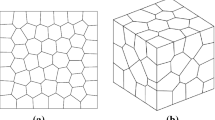Summary
The boundary-value problem for rods having arbitrary geometry, and subjected to arbitrary loading, is studied within the context of the small-strain theory. The basic assumptions underlying the rod kinematics are those corresponding to the Timoshenko hypotheses in the plane rectilinear case: that is, plane sections normal to the line of centroids in the undeformed state remain plane, but not necessarily normal. The problem is formulated in both the standard and mixed variational forms, and after establishing the existence and uniqueness of solutions to these equivalent problems, the corresponding discrete problems are studied. Finite element approximations of the mixed problem are shown to be stable and convergent. It is shown that the equivalence between the mixed problem and the standard problem with selective reduced integration holds only for the case of rods having constant curvature and torsion, though. The results of numerical experiments are presented; these confirm the convergent behaviour of the mixed problem.
Similar content being viewed by others
References
Arnold, D.N. (1981): Discretisation by finite elements of a model parameter dependent problem. Numer. Math.37, 405–421
Arunakirinathar, K., Reddy, B.D.: A closed-form solution for lincar elastic rods having constant curvature and torsion. In review
Brezzi F. (1974): On the existence, uniqueness and approximation of saddle point problems arising from Lagrange multipliers. RAIRO Anal. Numér.8, 129–151
Brezzi, F., Fortin, M. (1991): Mixed and hybrid finite element methods. Springer, Berlin Heidelberg New York
Ciarlet, P.G. (1978): The finite element method for elliptic problems. North-Holland, Amsterdam
Girault, V., Raviart, P.-A. (1986): finite element methods for Navier-Stokes equations. Springer, Berlin Heidelberg New York
Kikuchi, F. (1982): Accuracy of some finite element models for arch problems. Comput. Meth. Appl. Mech. Engng.35, 315–345
Kikuchi, F. (1985): An abstract analysis of parameter dependent problems and its applications to mixed finite element methods. J. Fac. Sci. Univ. Tokyo, Sect. IA32, 499–538
Loula, A.F.D., Hughes, T.J.R., Franca, L.P., Miranda, I. (1987): Stability, convergence and accuracy of a new finite element method for the circular arch problem. Comp. Meth. Appl. Mech. Engng.63, 281–303
Rektorys K (1980): Variational methods in mathematics, science and engineering. Reidel, Dordrecht
Reddy, B.D. (1986): Functional analysis and boundary value problems: An introductory treatment. Longman, London
Reddy, B.D. (1988): Convergence of mixed finite element method approximations for the shallow arch problem. Numer. Math.53, 687–699
Reddy, B.D., Volpi, M.B. (1992): Mixed finite element method for the circular arch problem. Comput. Meth. Appl. Mech. Engng.97, 125–145
Simo, J.C. (1985): A finite strain beam formulation. The three-dimensional dynamic problem. Part I. Comput. Meth. Appl. Mech. Engng.49, 55–70
Author information
Authors and Affiliations
Rights and permissions
About this article
Cite this article
Arunakirinathar, K., Reddy, B.D. Mixed finite element methods for elastic rods of arbitrary geometry. Numer. Math. 64, 13–43 (1993). https://doi.org/10.1007/BF01388679
Received:
Issue Date:
DOI: https://doi.org/10.1007/BF01388679



